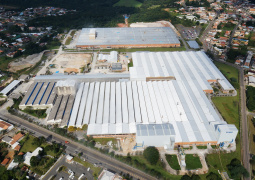Incepa Responds: understand the differences between types of polished porcelain tiles

Thanks to its versatility, durability, and high quality, porcelain tile has become a key piece for many designers and architects. In addition to being a piece with unquestionable aesthetics, they can be used in different areas, both internally and externally.
These characteristics made them also become objects of consumer desire, as they have a huge range of prints and a wide variety of finishes available.
However, some care is needed when choosing the wall tile. Some technical characteristics must be taken into account, such as resistance, brightness intensity, and whether the product is suitable for the place where you want to place it.
In this text from Incepa Responds, we will explain the difference between satin and polished porcelain tile. If you want to know more about the technical characteristics of this type of product, click here and access our complete guide!
Before we start, it is worth remembering some important information about porcelain tiles. They are ceramic wall tiles that have higher mechanical strength and lower porosity when compared to traditional ceramics. This is due to its low water absorption rate, which varies between 0.1% and 0.5%.
Remember that mechanical strength corresponds to the part’s ability to withstand the weight exerted on it, without breaking. In turn, porosity is directly related to water absorption, the lower the porosity of the product, the lower the water absorption and the higher the resistance index.
Incepa porcelain tiles are divided according to their finish. Altogether, we have 03 groups: Enameled Porcelain Tiles, Plus Porcelain Tiles, Tuttomassa Porcelain Tiles and Technical Porcelain Tiles, the latter having the following subgroups: Polished, Natural and Structured finish.
Porcelain tiles Polished versus Satin
As we have seen, these terms are related to the finish of the product, that is, its surface. Below, check out the main differences between these two models. Enjoy!
Polished porcelain tiles
Polished tiles fall into the category of Technical porcelain tiles. Therefore, they have the lowest water absorption (≤ 0.1%) and have high mechanical strength. Another characteristic is that, as they do not receive the imprint of the stamp on the surface, the wear over time is practically null.
As its name suggests, porcelain tiles with a polished finish are polished in their manufacturing process. As a result, we have parts with a smooth and shiny surface, characteristic of this product.
Its intense brightness gives elegance to spaces, bringing personality and refinement to the environment. However, they are not suitable for wet areas, such as bathrooms, kitchens, and swimming pools, as they have smooth surfaces and do not absorb water, making them slippery.
Our recommendation is to use polished porcelain tile in dry rooms, such as living rooms, hallways, and bedrooms, or in wet areas. Remember that wettable surfaces are those that can receive splashes, but without the formation of water slides.
Another point of attention is that its shine makes it more susceptible to scratches, so it requires careful cleaning. For this, use only a damp cloth and neutral products, with pH 7.
Incepa has several products that fit this category and, as if the unmistakable shine were not enough, the pieces have a rectified finish and joints of only 1mm, the smallest on the market.
The first model is the Calacata. The series was inspired by the classic Calacata Bianco marble, a symbol of elegance and an object of desire revered by architecture. Thanks to HD printing technology, we were able to faithfully reproduce natural stone, with all the nuances of color, variations in veins, and amplitude of format.

Another wall tile that also has a polished surface is the Nordico series products. With a basic and timeless design, the pieces fit into proposals and solutions for spaces of all sizes.
You can find them in 12 different colors, with shades ranging from white to gray. In addition, they are available in ground versions with a minimum joint of 1mm.

Satin porcelain tiles
Porcelain tile with a satin finish is one where you run your hand and feel a soft surface. To achieve this result, the pieces go through a brushing process, resulting in a silky and smooth texture.
Like the polished ones, they can be used in dry or wet indoor areas, with heavy traffic. As it does not receive the glossy enamel layer, it is not very slippery and has less chance of scratching than polished porcelain tile. For this reason, it is suitable for homes with pets and children.
Incepa’s Pro series is one of the examples of products that have this type of finish. Basic and essential, it has a wide range of colors, all with neutral and sober tones.
The pieces are available in bold and rectified versions, for internal or external areas. They are suitable for both residential and commercial spaces.

The Liverpool series is another example of polished porcelain tile. The pieces in this series were inspired by the famous London lofts. With a texture that imitates burnt cement, it refers to the industrial style and makes this product a protagonist in bold and cosmopolitan projects.

After reading, we hope you have understood the differences between satin and polished porcelain tiles. As we can see, each finish is suitable for an environment, so choose the one that meets your needs and matches your project. Any questions, we are here to help.



